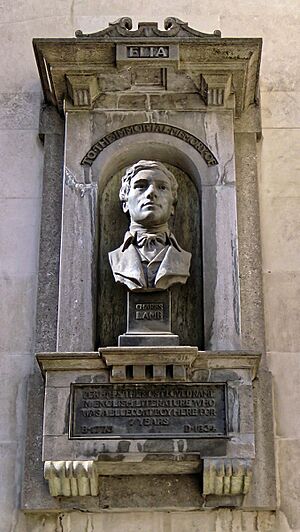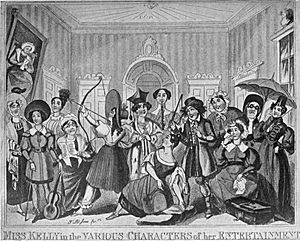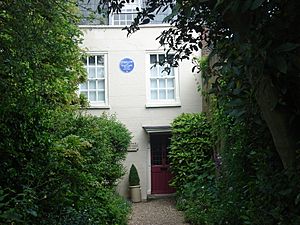Charles Lamb facts for kids
Quick facts for kids
Charles Lamb
|
|
|---|---|
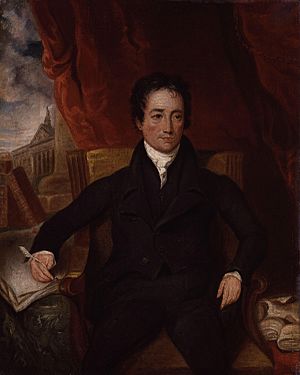
Portrait by Henry Hoppner Meyer
|
|
| Born | 10 February 1775 Inner Temple, London, England
|
| Died | 27 December 1834 (aged 59) Edmonton, London, England
|
| Other names | Elia |
| Known for | Essays of Elia Tales from Shakespeare |
| Relatives | Mary Lamb (sister) John Lamb (brother) |
Charles Lamb (born February 10, 1775 – died December 27, 1834) was an English writer. He wrote essays, poems, and studied old things. He is most famous for his book Essays of Elia. He also wrote the children's book Tales from Shakespeare with his sister, Mary Lamb (1764–1847).
Charles Lamb was friends with many famous writers like Samuel Taylor Coleridge, Robert Southey, William Wordsworth, and William Hazlitt. He was a central figure in a big group of writers in England. His main biographer, E. V. Lucas, called him "the most lovable figure in English literature."
Contents
Early Life and School Days
Charles Lamb was born in London. His parents were John Lamb (born around 1725) and Elizabeth (died 1796). Charles had an older brother and sister. Four other siblings did not live past infancy. His father, John Lamb, worked as a lawyer's assistant for Samuel Salt. They lived in the Inner Temple, a legal area in London. Charles was born and grew up there.
Charles's older brother was much older than him, so they weren't close playmates. But his sister Mary, who was eleven years older, was likely his best friend. His aunt Hetty also helped care for him and seemed to like him a lot. Charles wrote fondly about his aunt, saying her presence brought him comfort.
Childhood Memories and Education
Some of Charles's favorite childhood memories were spent with his grandmother, Mrs. Field. She worked for the Plumer family at their large country house called Blakesware, near Widford. After Mrs. Plumer died, Charles's grandmother was in charge of the house. Charles could explore the house freely during his visits. He wrote about these visits in his essay Blakesmoor in H—shire.
We don't know much about Charles's life before he was seven. We do know that Mary taught him to read very early, and he read a lot. He might have had smallpox when he was young, which made him rest for a long time. After he recovered, Charles took lessons from Mrs. Reynolds, a woman who lived in the Temple. Charles stayed friends with her his whole life.
Around 1781, Charles started studying at the Academy of William Bird. However, he didn't stay there long. By October 1782, Lamb was enrolled in Christ's Hospital. This was a charity boarding school started by King Edward VI in 1553. Charles wrote about his time at Christ's Hospital in several essays. He also became lifelong friends with Samuel Taylor Coleridge there. Even though the school could be tough, Charles did well. His home was close by, so he could visit often, which was a comfort.
Starting a Career
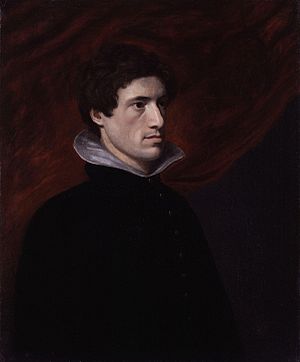
Charles Lamb had a stutter, which is a speech difficulty. Because of this, he couldn't become a scholar at Christ's Hospital. This meant he couldn't go to Cambridge University like Coleridge. Charles left school at fourteen and had to find a job.
For a short time, he worked for a London merchant named Joseph Paice. Then, he worked for 23 weeks at the Examiner's Office of the South Sea House. On April 5, 1792, he started working in the Accountant's Office for the British East India Company. He worked there for 25 years until he retired with a pension.
In 1792, Charles Lamb fell in love with a young woman named Ann Simmons. He spent years trying to win her over. He wrote about this love in his story "Rosamund Gray" and in some of his essays, where he called her "Alice M." However, Miss Simmons eventually married someone else. Charles called this failed romance his "great disappointment."
Adult Life and Challenges
Both Charles and his sister Mary experienced periods of mental health challenges. Mary's illness was more serious than Charles's. Charles took care of Mary. He refused his brother's idea to send her to a public mental health hospital. Instead, Charles used much of his money to keep his beloved sister in a private care facility in Islington.
When his father, John Lamb, died in 1799, it was a relief for Charles. His father had been unwell for several years after having a stroke. His father's death also meant Mary could come live with him again. In 1800, they set up a home together in Mitre Court Buildings in the Temple, where they lived until 1809.
In 1800, Mary's illness returned, and Charles had to take her back to the care facility. Later, she returned home. Both Charles and Mary enjoyed a busy and rich social life. Their home in London became a weekly gathering place for many famous writers and theater people of the time. In 1869, a club called The Lambs was formed in London to continue their tradition of social gatherings.
Friends and Early Writings
Charles Lamb's oldest and closest friend was Samuel Taylor Coleridge, who he had met at school. When Coleridge was dying, he sent a special ring to Charles and Mary. Charles's first published work was in 1796. Four of his poems appeared in Coleridge's book Poems on Various Subjects. In 1797, he added more poems to the second edition. During a summer holiday with Coleridge, he met William and Dorothy Wordsworth, starting another lifelong friendship. In London, Lamb also became friends with other young writers who wanted political change, such as Percy Bysshe Shelley, William Hazlitt, Leigh Hunt, and William Hone.
Charles Lamb continued to work for the East India Company while also writing. His play, John Woodvil, was published in 1802. His comedy, Mr H, was performed in 1807 but was not well-received. In the same year, Tales from Shakespeare was published. Charles wrote the summaries for the tragedies, and Mary wrote the comedies. This book became a bestseller for William Godwin's "Children's Library."
On July 20, 1819, when he was 44, Charles Lamb fell in love with an actress named Fanny Kelly. He wrote her a poem and asked her to marry him. She said no, and he remained unmarried.
His collected essays, titled Essays of Elia, were published in 1823. "Elia" was the pen name Charles used when he wrote for The London Magazine. Another collection, The Last Essays of Elia, was published in 1833, shortly before his death.
Later Years and Death
In 1834, Samuel Coleridge died. Charles Lamb was not able to attend the funeral, but he wrote a letter expressing his sadness.
On December 27, 1834, Charles Lamb died at age 59. He got a skin infection after slipping in the street and grazing his face. From 1833 until their deaths, Charles and Mary lived in Bay Cottage in Edmonton, north of London. Charles Lamb is buried in All Saints' Churchyard, Edmonton. His sister Mary, who was ten years older, died more than a dozen years after him. She is buried next to him.
Charles Lamb's Writings
Charles Lamb's first published works were four poems in Coleridge's Poems on Various Subjects in 1796. These poems were influenced by Burns and William Bowles. However, Lamb's poems didn't get much attention and are not often read today. He later realized he was much better at writing prose (regular sentences and paragraphs) than poetry. William Wordsworth, a famous poet, even said in 1815 that Lamb "writes prose exquisitely." This was five years before Lamb started his most famous work, The Essays of Elia.
Lamb's poems in Coleridge's second edition showed he was growing as a poet. These included The Tomb of Douglas and A Vision of Repentance. Lamb also published a book called Blank Verse with Charles Lloyd. Lamb's most famous poem from this time is The Old Familiar Faces. Like most of his poems, it is very emotional. Because of this, it is still remembered and read today.
In the late 1700s, Lamb started writing prose. His first novella was Rosamund Gray. It tells the story of a young girl, thought to be based on Ann Simmons, his early love. Even though the story's plot wasn't very strong, other writers liked it. Shelley said, "what a lovely thing is Rosamund Gray! How much knowledge of the sweetest part of our nature in it!"
Working with Mary Lamb
In the early 1800s, Charles began working with his sister Mary on books. Together, they wrote at least three books for William Godwin's Juvenile Library. The most successful was Tales From Shakespeare. This book has been published many times since then. It contains clever summaries of some of Shakespeare's most loved plays. Charles mainly worked on Shakespeare's tragedies, while Mary focused on the comedies.
Charles Lamb also wrote an essay called "On the Tragedies of Shakespeare Considered with Reference to their Fitness for Stage Representation." In this essay, Lamb argued that Shakespeare's plays should be read, not performed on stage. He believed this would protect Shakespeare's work from being poorly performed.
Lamb also helped people learn more about Shakespeare's fellow writers from the 1600s. In 1808, he put together a collection of writings from old playwrights called Specimens of the English Dramatic Poets Who Lived About the Time of Shakespeare. This book also included his thoughts on these writers. Reading authors from the 1600s, like Robert Burton and Sir Thomas Browne, also changed Lamb's writing style. His friend, the essayist William Hazlitt, described Lamb's writing: "Mr. Lamb ... does not march boldly along with the crowd .... He prefers bye-ways to highways." This means Lamb liked to explore less common ideas and details in his writing.
Although he didn't write his first "Elia" essay until 1820, Lamb started working on his famous essay style around 1811. He wrote a series of open letters for Leigh Hunt's Reflector. One famous early essay is "The Londoner." In it, Lamb made fun of people's interest in nature and the countryside. He continued to improve his writing style for the next 25 years.
Religious Beliefs
Christianity was important in Charles Lamb's life. Even though he wasn't a regular churchgoer, he "sought comfort in religion." He wrote letters saying the New Testament was his "best guide" for life. He also remembered reading the Psalms for hours without getting tired. Other writings also show his Christian beliefs. Like his friend Coleridge, Lamb was open to Priestleyan Unitarianism and was a Dissenter. Coleridge said Lamb's "faith in Jesus ha[d] been preserved" even after family difficulties. Wordsworth also called him a strong Christian.
Lamb's poems like "On The Lord's Prayer," "A Vision of Repentance," and "Charity" show his religious faith. His poem "Living Without God in the World" criticizes atheism, saying it comes from pride.
Charles Lamb's Legacy
Charles Lamb's works have always had a small but loyal group of fans. Because of his unique and sometimes strange writing style, he is more of a "cult favorite" than a widely popular author. Anne Fadiman noted that Lamb is not widely read today. She wondered why more readers aren't interested in his work.
Two houses at Christ's Hospital, his old school, are named in his honor (Lamb A and Lamb B). The Latymer School, a school in Edmonton where he lived, also has a house named Lamb after him. A major award at Christ's Hospital School, "The Lamb Prize for Independent Study," is given each year.
Sir Edward Elgar wrote an orchestral piece called Dream Children. He was inspired by Lamb's essay of the same name.
A quote from Lamb, "Lawyers, I suppose, were children once," is used at the beginning of Harper Lee's famous novel To Kill a Mockingbird.
The Charles Lamb pub in Islington is named after him.
Henry James Montague, who started The Lambs Club, named it after the social gatherings held by Charles and his sister Mary.
Charles Lamb also plays an important part in the story of Mary Ann Shaffer and Annie Barrows's novel, The Guernsey Literary and Potato Peel Pie Society.
Selected Works
- Blank Verse, poems, 1798
- A Tale of Rosamund Gray, and Old Blind Margaret, 1798
- John Woodvil, verse drama, 1802
- Tales from Shakespeare, 1807
- The Adventures of Ulysses, 1808
- Specimens of English Dramatic Poets who Lived About the Time of Shakespeare, 1808
- On the Tragedies of Shakespeare, 1811
- Witches and Other Night Fears, 1821
- Essays of Elia, 1823
- The Pawnbroker's Daughter, 1825
- The Last Essays of Elia, 1833
- Eliana, 1867
See also
 In Spanish: Charles Lamb para niños
In Spanish: Charles Lamb para niños


